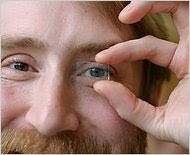
Scientists: Arctic Ozone Depletion ‘unprecedented’
By: Stephanie Nebehay
An article from World Environment on NBC.com
April 4th, 2011
Summary
The article I read is all about how the ozone layer has had a record loss this past winter. In fact, the United Nations agency said that from the beginning of the winter to late March, the ozone column lost 40 percent of its mass. That’s a lot, and was an amount unheard of until now.
In previous years, the highest mass ever lost was 30 percent. This occurred during several seasons for 15 years, so for the ozone layer to lose 40 percent in one winter, that’s just unbelievably terrible.
The area where the ozone layer is depleted can move. And if it moves toward lower latitudes, ultraviolet (UV) radiation will be higher than normal in the upcoming seasons for those areas. So a depleted ozone layer doesn’t just affect one spot, it affects a large, widespread area. A spokesperson from the World Meteorological Organization advised people to check UV forecasts for their areas, because less of the ozone layer means less protection from the sun’s harmful rays.
If the depleted ozone layer is to move away from the Arctic towards lower latitudes, it would affect some of Russia, Canada, Nordic countries, and even Alaska in the US. However, a UV radiation increase in those parts of the world would be less intense than if the increase was to take place in the tropics.
Not only people are affected by UV rays (which contribute to immune system damage, skin cancer, and cataracts in humans). Marine life and crops can also suffer from harmful effects.
Over Antarctica, large ozone loss is not uncommon. In fact, it occurs every year. This is extremely different from the Arctic stratosphere, because conditions there vary each year.
The Montreal Protocol was an international agreement to cut production and consumption of halons, chlorofluorocarbons (CFCs), and other ozone-destroying chemicals. It was thought to be very successful (The 1987 pact eliminated substances like CFCs and halons that used to be used in fire extinguishers, spray cans, and refrigerators), but for some reason the drastic ozone mass loss still occurred.
Any way you look at it, the recent ozone mass loss was extremely drastic and is going to have adverse effects on humans, marine life, and crops alike.
Opinion/Reflection
I personally think that the ozone loss is extremely terrible. It’s almost unbelievable that 40 percent of the ozone layer’s mass could be lost in one winter when previously the highest amount heard of was a 30 percent loss. That just shows how bad people are. We need to stop using ozone-depleting substances.
I feel that until the UV rays start increasing in many areas of lower latitude around the world, people won’t realize what they’ve done. Sure, people will see news stories (like this one) and hear scientists talk about the damage, but they won’t understand the full impact until they see some changes. It’s sad, though, because UV rays cause cataracts, skin cancer, and immune system damage, so by the time people truly realize what they’ve done, it will be too late. People will have to learn the hard way, unfortunately.
I believe it is extremely unfair for marine life to have to suffer on our behalf. They’re not doing anything to harm the ozone layer, they’re not using ozone-depleting substances, so why should they be affected? The thing is they shouldn’t. But humans and animals are all on the same earth, so anything that one species does will affect the other. It’s extremely sad, and I feel really bad for the animals who have to suffer despite the fact that they aren’t doing anything wrong.
I also feel bad for people who don’t pollute atmosphere. If people don’t want the ozone layer to keep losing its mass, then everyone has to work together to try and stop it. This doesn’t just mean the people in America, though. People from all over the world have to pitch in and stop using ozone-depleting substances, or the damage that we have caused will continue to get worse.
Finally, I thought that the Montreal Protocol was a very good idea, and it’s sad that more people don’t abide by its rules. After all, the agreement was made for the well being of humans and the only people we’re hurting by not following is ourselves. And that’s just sad.
This article relates to class because we started learning about the atmosphere and one of the important parts of the atmosphere is the ozone layer. It helps protect people from the sun’s harmful rays, and without it, I don’t know if humans or other forms of life would be around.
Ask Questions
1. What other effects can UV rays have on humans?
2. Name some ways in which marine life and crops will have to suffer because of the ozone layer depletion.
3. Why do you think people keep using ozone-depleting substances, even though they make the ozone layer lose mass?
4. Do you think people will realize what they’re doing soon, or not until it’s too late? What do you consider that too late to be?
5. Why do you think that having ozone depletion over the tropics would be more intense than having ozone depletion elsewhere? (by intense I mean it makes people suffer more)
I realize now that this question should say more intense, but I didn't want to change it and mess everyone's comments up.
6. How come the ozone lost so much mass recently, other than the obvious fact that people are continuing to use ozone-depleting substances?
Graphics
Left: This image shows the logo for the Montreal Protocol
Right: This picture shows the UV radiation that hits towns and people when the ozone layer is there compared to the amount of UV rays that hit towns and people when the ozone layer is gone.



